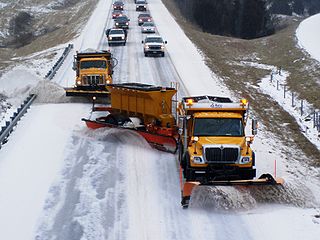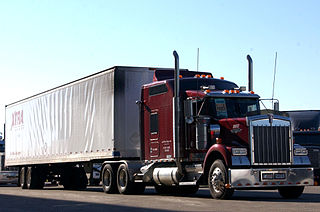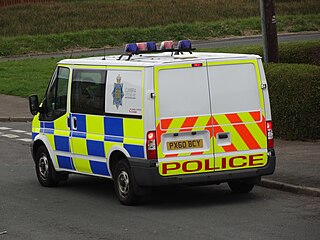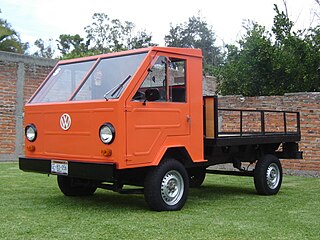 W
WA commercial vehicle is any type of motor vehicle used for transporting goods or paying passengers. The European Union defines a "commercial motor vehicle" as any motorized road vehicle, that by its type of construction and equipment is designed for, and capable of transporting, whether for payment or not: (1) more than nine persons, including the driver; (2) goods and "standard fuel tanks". This means the tanks permanently fixed by the manufacturer to all motor vehicles of the same type as the vehicle in question and whose permanent fitting lets fuel be used directly, both for propulsion and, where appropriate, to power a refrigeration system. Gas tanks fitted to motor vehicles for the direct use of diesel as a fuel are considered standard fuel tanks.
 W
WAn armored vehicle is an armored van or truck, used in transporting valuables, such as large quantities of money. The armored car is typically a multifunctional vehicle designed to protect and ensure the wellbeing of the transported individuals and/or contents. Often, armored cars are bulletproof and can withstand extreme degrees of heat. These vehicles are mostly utilized by the military, but many companies such as Mercedes, Lexus, Lincoln, Toyota, Cadillac, Audi, and BMW have created armored cars for civilian use, usually to protect valuables and dignitaries. Armored cars have an armored shell and cab, and typically are customized on a basic van or truck chassis. These vehicles are designed to resist attempts at robbery and hijacking. Bullet-resistant glass and reinforced shells and cabs are designed to resist bullets from most handguns and rifles.
 W
WThe Chevrolet Stepvan is a step-van made by Chevrolet from 1941 to 1978.
 W
WA combination car was a vehicle that could serve either as a hearse or as an ambulance, and had the capability of being swapped between those roles without much difficulty. This hybrid usage of the cars reflects an era when funeral homes offered emergency ambulance service in addition to their primary trade, especially in smaller towns and rural areas.
 W
WFleet vehicles are groups of motor vehicles owned or leased by a business, government agency or other organization rather than by an individual or family. Typical examples are vehicles operated by car rental companies, taxicab companies, public utilities, public bus companies, and police departments. In addition, many businesses purchase or lease fleet vehicles to deliver goods to customers, or for sales representatives to travel to clients. In some jurisdictions and countries, fleet vehicle also means vehicles that are privately owned by employees, or on novated leases, but are used for work purposes; this is called the 'grey fleet'.
 W
WThames was a commercial vehicle brand produced by Ford of Britain, a subsidiary of The Ford motor company, from 1952 until.
 W
WA hearse is a large vehicle, especially an automobile, used to carry the dead body of a person in a coffin/casket at a funeral, wake, or memorial service. They range from deliberately anonymous vehicles to very formal heavily decorated vehicles.
 W
WHours of Service (HOS) regulations are issued by the Federal Motor Carrier Safety Administration (FMCSA) and govern the working hours of anyone operating a commercial motor vehicle (CMV) in the United States. These regulations apply to truck drivers, commercial and intercity bus drivers, and school bus drivers who operate CMVs. These rules limit the number of daily and weekly hours spent driving and working, and regulate the minimum amount of time drivers must spend resting between driving shifts. For intrastate commerce, the respective state's regulations apply.
 W
WThe Hyundai Starex is a light commercial, 4-door van built by the Hyundai Motor Company in South Korea and Indonesia since 1997.
 W
WAn Ice cream cart is a mobile non-motorized commercial vehicle that sells ice cream as a retail outlet. The Ice cream cart is usually used during the summer and is generally spotted at public space, parks, beaches, schools or drive through neighborhoods. Sometimes a bicycle is attached to the cart, in order to improve its mobility.
 W
WThe International 9000 Series is a range of trucks that was manufactured by Navistar International. Introduced as the Transtar 4000 in 1971, the model line was produced across three generations until 2017; following the incorporation of Navistar, the Transtar was rebranded as the 9000 series. Slotted below the Paystar range, the 9000 series was a conventional-cab truck configured primarily for highway applications.
 W
WThe International S series is a range of trucks that was manufactured by International Harvester from 1977 to 2001. Introduced to consolidate the medium-duty IHC Loadstar and heavy-duty IHC Fleetstar into a single product range, the S series was slotted below the Transtar and Paystar Class 8 conventionals.
 W
WThe International TranStar, is a range of Class 8 trucks produced by Navistar International for North America. Produced nearly exclusively as a semitractor, the product range is focused towards local delivery and regional shipping.
 W
WA Kei truck, or Kei class truck, or Japanese mini truck is a mini truck, a tiny but practical pickup truck available in RWD or 4WD version, built to satisfy the Japanese keijidōsha statutory class. They are known as Keitora in Japan alongside the microvan.
 W
WA light commercial vehicle (LCV) in the European Union, Australia, New Zealand is a commercial carrier vehicle with a gross vehicle weight of no more than 3.5 metric tons (tonnes). The LCV designation is also occasionally used in both Canada and Ireland.
 W
WA microvan is a van or minivan that fits into Japanese kei car classification or similar, and is smaller than a mini MPV.
 W
WMulti-stop trucks are a type of light-duty and medium-duty truck created for local deliveries to residences and businesses. They are designed to be driven either sitting down or standing up, and often provide easy access between the driver and goods, hence the name “walk-in delivery” van. They are taller than full-size vans, such as the Ford Econoline, Dodge A-Series/B-Series/Ram Vans, and Chevrolet G-Series vans, but can have wheelbases that are shorter than these models or longer.
 W
WThe concept of the Mechanical Horse tractor unit with an easily detached articulated trailer was conceived in the early 1930s by Napier & Son. It has one front wheel in the midline. The London and North Eastern Railway had approached Napier for an answer to the problem of replacing horses for local haulage purposes, while retaining the flexibility of changing the wagons and the manoeuvrability of the horse and wagon.
 W
WA snowplow is a device intended for mounting on a vehicle, used for removing snow and ice from outdoor surfaces, typically those serving transportation purposes. Although this term is often used to refer to vehicles mounting such devices, more accurately they are known as winter service vehicles, especially in areas that regularly receive large amounts of snow every year, or in specific environments such as airfields. In other cases, pickup trucks and front end loaders are outfitted with attachments to fulfill this purpose. Some regions that do not frequently see snow may use graders to remove compacted snow and ice off the streets. Snowplows can also be mounted on rail cars or locomotives to clear railway tracks.
 W
WThe trucking industry serves the American economy by transporting large quantities of raw materials, works in process, and finished goods over land—typically from manufacturing plants to retail distribution centers. Trucks are also used in the construction industry, as dump trucks and portable concrete mixers move the large amounts of rocks, dirt, concrete, and other building materials used in construction. Trucks in America are responsible for the majority of freight movement over land and are tools in the manufacturing, transportation, and warehousing industries.
 W
WA van is a type of road vehicle used for transporting goods or people. Depending on the type of van, it can be bigger or smaller than a truck and SUV, and bigger than a common car. There is some varying in the scope of the word across the different English-speaking countries. The smallest vans, microvans, are used for transporting either goods or people in tiny quantities. Mini MPVs, compact MPVs, and MPVs are all small vans usually used for transporting people in small quantities. Larger vans with passenger seats are used for institutional purposes, such as transporting students. Larger vans with only front seats are often used for business purposes, to carry goods and equipment. Specially-equipped vans are used by television stations as mobile studios. Postal services and courier companies use large step vans to deliver packages.
 W
WVillage vehicles are a particular type of very light goods vehicle used on the outlying islands in Hong Kong where there is no road connection. They are often used to transport goods around the islands from the ferry pier where they are deposited. There is no standard layout for village vehicles, they may have wheels or treads, use a steering wheel or a tiller, the major defining feature is their size and use.
 W
WThe Volkswagen EA489 Basistransporter was a small front-wheel drive platform truck with a front-mounted Volkswagen air-cooled engine. Created by Volkswagen AG, it was about the size of a modern-day Volkswagen Polo and is perhaps one of the rarest Volkswagens in the world because it was never sold in a developed market.